The Best Teachers
Those with the most experience to share about what health care providers need to know to help patients are often the patients themselves.
Rachel Adams, a Brenau University occupational therapy master’s degree candidate from Celina, Tennessee, fessed up instantly: She had cheated. Then, she laughed about it.
She was not the only one. In the auditorium of Shepherd Center, an Atlanta rehabilitation hospital primarily for patients with spinal cord and brain injuries, all Adams had to do to find other cheaters was to look to her left at Becca Fiscal from Avondale Estates, Georgia, or to her right at Jordan Lutz from Toledo, Ohio.
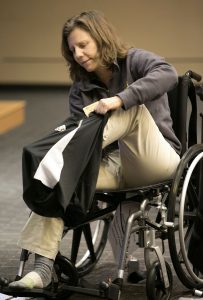
“Totally cheated,” Adams said.
“I did it, too,” Fiscal seconded.
Lutz admitted nothing.
On this particular exercise, teaching students how to put on shorts while sitting in a wheelchair, “not cheating” meant bringing one leg up and crossing it on the other leg. You could only use your arms. No leg muscles whatsoever.
Although that sounds simple enough, the only one in the group guilty of not cheating was 20-year-old Ally Poole. She could not cheat if she wanted to. She is paralyzed from the waist down from a January 2015 car crash that almost claimed her life.
“It happens,” Poole reassured Adams and the others. “It’s hard not to use your leg – when you can.”
The three students were part of a group of 26 from the university’s hybrid online/on campus occupational therapy program at the Norcross, Georgia, campus. They spent a day in March with a handful of former and current Shepherd Center patients who volunteered their time and wisdom to help these future occupational therapists gain practical experience that they could never get in a classroom. During three hours of hands-on demonstration labs, there was plenty of laughter, lots of encouragement and from time to time, correction – usually from a Shepherd Center therapist, but once or twice from the patients themselves. Although learning from books is a crucial part of the educational process, learning in the real world was invaluable, said the students, most of whom had never worked directly with patients.
“This was an incredible experience,” Fiscal said. “It takes so much to learn and remember everything in books. Seeing what it really looks like, physically interacting with patients, is a whole other deal.”
Fiscal, however, does have more experience of other sorts than her classmates. She’s older. She has two children, 11 and 15. And she was a schoolteacher for years before she discovered “what I wanted to be in life.”
“So the life experiences I’ve had make it a little easier to jump in and not be too concerned about things like personal space boundaries. I just jump right in.”
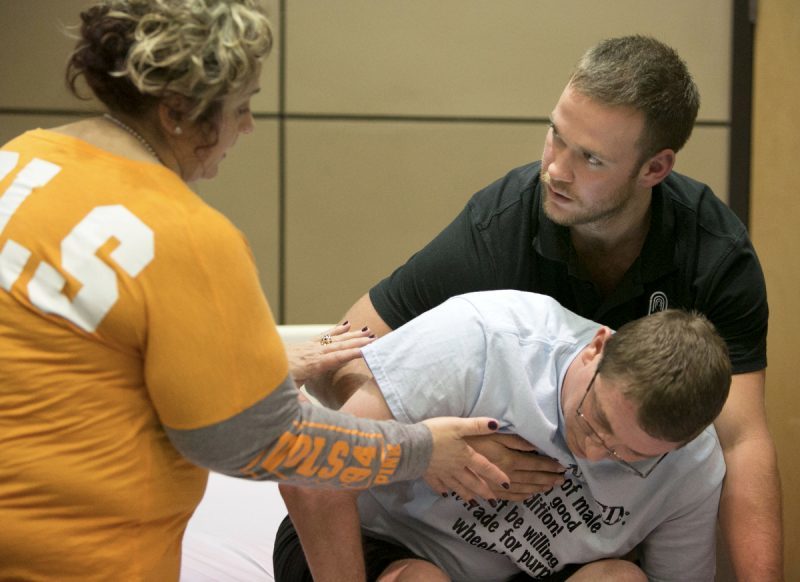
Invading ‘Personal Space’
Overcoming concerns that you are violating a patient’s personal space is a very real, very common issue that occupational therapy students must get past quickly. Shepherd Center occupational therapist Katie Kimbell demonstrated how to help a patient do a “throwback” on Toy Wix, a Tennessee man who has paraplegia. The maneuver involved getting on a table behind Wix, putting her chin on his shoulder and pressing her body close to his – almost like the mat starting position in an amateur wrestling match.
Then, student Meredith Burgamy more tentatively moved into position to take her turn. Kimbell “offered instruction” without opening her mouth. She gently pushed on Burgamy’s back until Burgamy’s torso was flush with Wix’s back, and her chin resting on his shoulder.
“Students initially tend to be timid about personal space, touching,” said. Wix’s wife, Spencer, who has returned to Shepherd five times specifically to work with the Brenau OT students. “They’re afraid they are going to offend us or something. They’ve got to learn that they’ve got to get in there. There’s no such thing as personal space anymore.”
Student Callie Setzer seemed to be soaking it all in with an enthusiastic, contagious spirit. But when it was time to do a transfer of patient Sarah Benzing from a wheelchair to a sofa, she was quick to speak up, but with her best idea: “I don’t want to go first.”
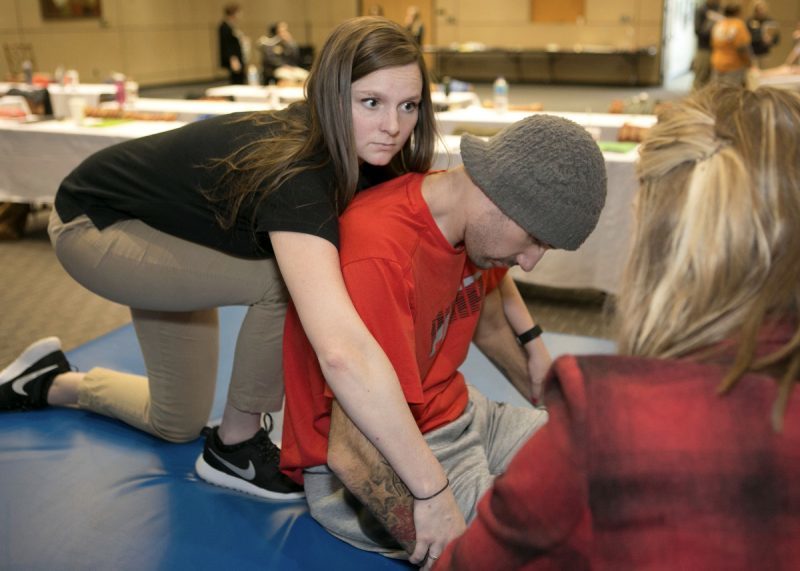
All 26 students, usually in small groups of three or so, got a couple of chances to transfer Benzing from her chair to the sofa. Benzing, now a young newlywed, injured her spinal cord two years ago when she fell from a deck that collapsed during a family Thanksgiving Day photo shoot celebrating her engagement.
“I was at the back against the railing,” she said. “The way it collapsed sent me backwards, and I dropped 15 feet, landing on my back. Others were injured, too, but I was the only one hurt this badly.”
Benzing’s spinal cord injury is classified as incomplete, meaning it wasn’t severed completely. Incomplete injuries usually result in better outcomes. Benzing is now able to walk around the house using leg braces and a walker. She was able to walk down the aisle at her wedding in April 2015, using full leg braces and flanked by her dad and brother.
“It was really hard, but it was a great goal to have,” she said.
In the exercise, 26 right hands and 26 left hands took their turn under Benzing’s behind. Occasionally, they’d be closer to her waist, but the instruction from Shepherd Center occupational therapy manager Teresa Foy was, “Basically, put your hands under her butt and let her lean forward into your arms.”
Remember that thing about personal boundaries? This one was a good litmus test on the students’ timidity. Benzing, a bit quiet and seemingly shy, only offered encouragement and affirmation to the students, even if she was doing more of the work than she was supposed to be doing.
“Don’t make it too easy on them,” Foy said. “Let them do the work.”
Hands-on Learning
Whoever was doing the work, by the end of the day, all the patients were completely worn out.
“I am beyond exhausted,” said Josh Hill, who was in his final days in the spinal cord injury inpatient rehabilitation program at Shepherd. His injury was one of the most severe and certainly the most recent. He was a big-rig driver who was carrying 10,000 rolls of heavy duty cardboard on a delivery. The weight shifted in the trailer and the truck flipped.
“It was 4 a.m., and when someone finally got to me, he said if I could crawl out the window, he’d get me some help,” Hill said. “I told him to get whatever was pinning my legs down off of them and I would. He said, ‘There’s nothing on your legs.’ That’s when I knew.”
His spinal cord is fused from the fourth to the seventh cervical vertebrae. He doesn’t know what his prognosis is. Right now, sitting on a mat without losing his balance is a challenge. But he labored through his routine time after time for new sets of students.
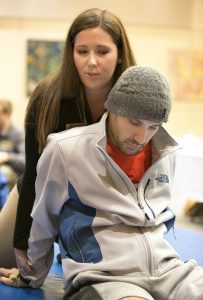
All of the patient volunteers were an inspiration, said the 23 year-old Tennessean Adams.
“I’m really grateful for the opportunity,” she said. “The therapists were helpful, but to talk to the volunteer patients, that was really was the best. They are best teachers we can have right now. They know what works best for dressing, or whatever the task is.
“It was all so eye opening. Even though we’ve been studying this and working with each other, you take things for granted like being able to lift your leg to cross it with the other one.”
Adams, Fiscal and Lutz could all see themselves working at Shepherd Center one day. But none of them are laser-focused yet on the exact area of occupational therapy they want to pursue.
“After seeing the patients at Shepherd Center, I can see myself working with people with spinal cord injuries,” Adams said.
Added Fiscal: “These guys are amazing and inspiring. The big takeaway for me is that these people don’t see themselves as poor victims. They have great attitudes and are going on with life, as happy or even happier than ever. A lot has to do with the environment here. It’s intentionally positive and not treating people as invalids. I could see myself working here.”
A couple of days after the experience at Shepherd Center, Lutz said, if anything, he was more impressed by the outing now that he’d had some time to think about it.
“Overall, it was great,” said Lutz, 24, of Toledo Ohio. “I learned a lot that I didn’t expect to find out about spinal cord injuries and what all it really entails. It got me interested in the spinal cord injury rehabilitation field. I guess I went in expecting to see an older age range, but they were all young adults. Also, I didn’t expect to see as many who were injured in car accidents.
“I also didn’t know just how wide the range of injuries would be. Josh and Toy basically have the same injury, but because Toy has had more time and experience figuring it out and getting some strength back, they’re in totally different places.”
All of this learning and hands-on experience comes under the tutelage of Dr. Robin Underwood, an occupational therapy professor at Brenau. She’s done this before, so she knew beforehand exactly what her students would experience.
“Coming in, they have no clue,” Underwood said. “When the stories are told, when they realize what these lives are like, the dedication of the spouses, how long it takes to do things, the first-hand experience, the students always write how this is their favorite experience.”
Ten Brenau graduates work as Shepherd Center therapists, Underwood said. Based on this spring day, that number might grow.
William Sanders, a longtime editor and investigative reporter in Augusta and Atlanta, is a freelance writer in Georgia.
A special ‘faculty’
Josh Hill, 30, Sophia, North Carolina
The big-rig driver says he is encouraged by the progress he has made since the Dec. 28 accident that put him in a wheelchair. He has some feeling in one arm, both hands and fingertips but still has not gained movement. Still, he said, after the first two weeks of his recovery on a ventilator unable to breathe on his own, “I’m sitting here talking to Brenau University students and helping them…. This is teaching them what they’re going to see when patients first get here. They seem like they want to do this. I sensed a little nervousness from them, but they weren’t scared to get on the therapy mat with me and help me do what I need to do.”
Ally Poole, 20, Bowden, Georgia
On Jan. 31, 2015, taking her dog to the vet, nursing student Poole swerved to avoid an oncoming hay truck. Thrown more than 50 feet from her flipped car, Poole, with shattered back, ruptured spleen, a neck fracture and severe internal bleeding, “died” on the helicopter lift to Atlanta. The trauma team revived her en route, but since her emergency room surgery, performed without anesthesia, Poole has been unable to move her legs and feet. Doctors have little optimism that Poole will regain feeling or walk. Poole, an aspiring physical therapist, believes she will. Just a month after her seven-week stay at Shepherd Center, she returned for her encounter with Brenau students. “I figured it would be good for them to know real life and that would make them better therapists,” she said. “They seem to be soaking it in, enthusiastic and excited to learn.”
Toy Wix, 39, Lafayette, Tennessee
While Wix worked on a cement truck at a job site on Aug. 29, 2014, a clogged hose released suddenly and knocked him into a pile of rebar. After surgery, doctors told him he likely would never be able to move any part of his body below his neck. Although he says he can live without use of his legs, “I’d really like to have use of my hands again.” To that end, he plans to go to Switzerland soon for stem cell treatment in hopes of regaining some movement in his hands. This was the fourth time Wix and his wife Spencer have volunteered with Brenau University students. “It makes me feel like I’m doing something useful,” he said, “because some days I don’t feel that way.”
Sarah Benzing, 23, Candler, North Carolina
Injured in late 2014 when a deck collapsed, Benzing walks short distances now with a walker, a big improvement from her first days at Shepherd when she felt almost nothing from the waist down. She is doing so well, she confesses that with the Brenau students, “I’m kind of having to fake it a little bit…. They always tend to be a little timid at first, but who wouldn’t be? Everyone has to get over that fairly quickly.” Now she wants to be an occupational therapist, too.
- Former Shepherd Center patient Toy Wix, far left, and his wife Spencer, far right, talk with Brenau University occupational therapy graduate students Victoria Kotkiewicz, from left, Julia Zametin & Callie Setzer about techniques to help people living with impairments and disabilities. Students got a chance to practice what they were taught during hands on labs at the Atlanta center that specializes in spinal cord & brain injury rehabilitation. (Phil Skinner for Brenau University)
- Brenau University occupational therapy graduate student Meredith Burgamy, top, and Shepherd Center occupational therapist Katie Kimball, right, laugh with former patient Toy Wix while practicing techniques to help people living with impairments and disabilities. Wix, injured while working on a construction job site, plans to go to Switzerland soon for a stem cell treatment in hopes of regaining some movement in his hands. (Phil Skinner for Brenau University)
- Brenau University occupational therapy graduate student Callie Setzer, left, asks a question of Spencer Wix, wife of former Shepherd Center patient Toy Wix. (Phil Skinner for Brenau University)
- Brenau University occupational therapy graduate student Lauren Tomy discovers how lean back a “Sip & Puff Power Wheelchair” by blowing on a straw. (Phil Skinner for Brenau University)
- Brenau University occupational therapy graduate students Becca Fiscal, right, and Rachel Adams learn how to put on shorts while in a wheelchair from former Shepherd Center patient Ally Poole. Poole returned just one month after a seven-week stay at the Shepherd Center to help the Brenau students. (Phil Skinner for Brenau University)
- Brenau University occupational therapy graduate student Jordan Lutz tries to use a special fork that can help those with disabilities eat without assistance. (Phil Skinner for Brenau University)
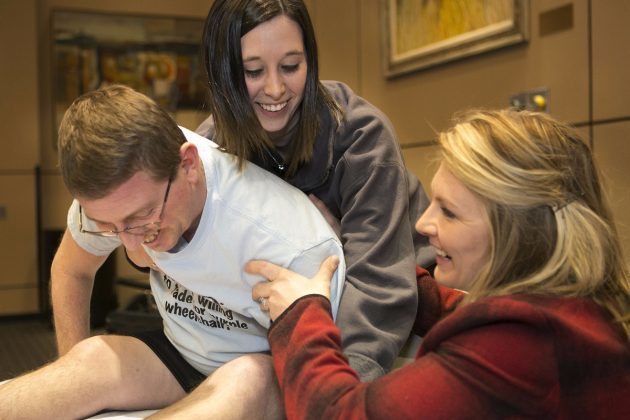
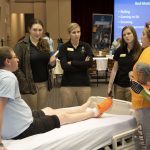
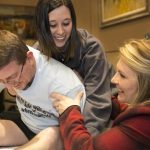
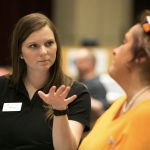
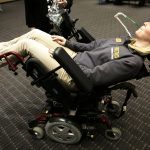
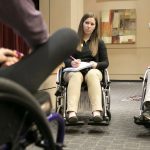
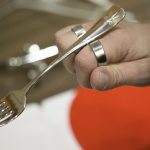

Nothing quite as informative as listening, whether to patients, clients ~ others.